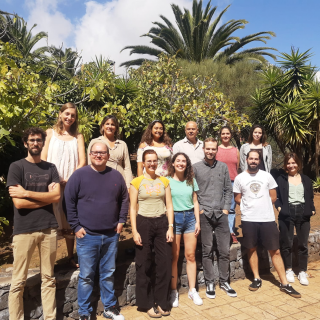Bibcode
Mostoghiu, R.; Di Cintio, A.; Knebe, Alexander; Libeskind, Noam I.; Minchev, Ivan; Brook, C.
Bibliographical reference
Monthly Notices of the Royal Astronomical Society, Volume 480, Issue 4, p.4455-4467
Advertised on:
11
2018
Citations
9
Refereed citations
9
Description
HST/ACS observations along the major axis of M33 show that the mean age
of its stars decreases with increasing distance from the galaxy centre.
Such a behaviour is consistent with an inside-out growth of the disc.
However, in the outermost observed field, at r ≃ 11.6 kpc, a
reversal of this gradient is detected, with old stars found in high
percentages beyond this radius. In this work, we investigate the origin
of such a reversal in stellar age gradient, by using a simulated M33
analogue from the Constrained Local UniversE Simulations (CLUES). The
simulated M33 is similar to the observed one in terms of mass, rotation
velocity, surface brightness, and, similar to what has been reported in
observations, shows a stellar age turnaround at large radii. We
demonstrate that this reversal is mostly a result of stellar accretion
from old satellite galaxies and, to a lesser extent, of stellar
migration of in-situ stars. The old accreted stars, with formation times
tf < 4 Gyrs, are kinematically hot and can be
differentiated from the in-situ stars by their high velocity dispersion
and the fact that they do not have rotationally supported orbits. In the
future, obtaining kinematic information of the stars in the outskirt of
M33 will help to verify this scenario.
Related projects

Numerical Astrophysics: Galaxy Formation and Evolution
How galaxies formed and evolved through cosmic time is one of the key questions of modern astronomy and astrophysics. Cosmological time- and length-scales are so large that the evolution of individual galaxies cannot be directly observed. Only through numerical simulations can one follow the emergence of cosmic structures within the current
Claudio
Dalla Vecchia

Traces of Galaxy Formation: Stellar populations, Dynamics and Morphology
We are a large, diverse, and very active research group aiming to provide a comprehensive picture for the formation of galaxies in the Universe. Rooted in detailed stellar population analysis, we are constantly exploring and developing new tools and ideas to understand how galaxies came to be what we now observe.
Ignacio
Martín Navarro